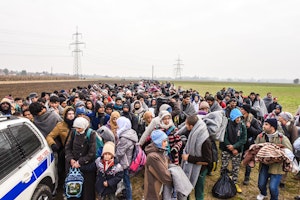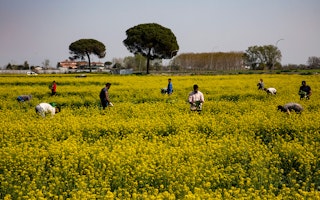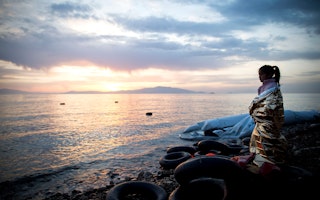Slovenia Built a “Corridor” to Move Refugees Straight Through the Country
By Neža Kogovšek Šalamon

In the fall of 2015 Slovenia faced an unprecedented influx of refugees and migrants, many of whom wanted only one thing: to cross through the country and get to Western Europe.
At first, the Slovenian authorities planned to treat the migrants according to standard border control protocols: they would allow only those applying for asylum in Slovenia to enter the country. Those simply using Slovenia as a “transit country” to get to Western Europe would be denied entry and promptly returned to neighboring Croatia.
It soon became clear, however, that this model was not designed to handle mass arrivals. Instead of receiving the returnees, the Croatian authorities, facing large groups of new arrivals at their country’s other border, ignored the requests of the Slovenian authorities to take the migrants back. So Slovenia resorted to a policy that was inconceivable until recently: it established a humanitarian “corridor” to provide the migrants safe passage through the country towards Austria.
Between October 2015 and January 2016, 419,205 migrants crossed through Slovenia using this corridor; only about 100 of them actually applied for asylum in Slovenia. The corridor—which is less a physical structure than a system whereby migrants arrive in Slovenia and the state helps usher them farther north—has no basis in law.
Normally, these migrants would have to apply for a visa to legally enter Slovenia; they would be required to present an array of documents, and their application would likely be rejected. But if they use this irregular way of traveling, they can pass through Slovenia without documentation, expediting their journey onward while allowing the state to essentially wash its hands of them.
Within the corridor, the transiting migrants are registered, and receive basic reception support and, ultimately, organized transportation towards the Austrian border. During this time, they are almost completely isolated from the local population and are prohibited from leaving the fenced areas, raising legal concerns around scenarios in which foreigners may be detained for immigration control purposes.
Instead, some of the refugees and migrants are issued a document called “permission to remain” which is granted to individuals who do not have the right to asylum, but also cannot return to their countries. This document protects from expulsion individuals who are likely to stay in Slovenia for a while without any particular legal status. But it does not apply to migrants and refugees in the corridor, whose only intention—as well as that of the state—is to leave the Slovenian territory as soon as possible.
This unusual scenario is unfolding against a backdrop in which racist, xenophobic, and Islamophobic sentiment is on the rise. This rhetoric has been fueled by political elites who, from the beginning, branded refugees as a threat to national security and Slovenia’s very identity. Calls for a humanitarian response to the crisis have disappeared from the political discussion. A razor-wire fence was set up along parts of Slovenia’s border with Croatia, and protests against new refugee centers have increased.
In Slovenian society, prejudice against ethnic and religious minorities runs deep. While there are a number of self-organized groups, volunteers, and NGOs providing assistance to the refugees, their welcoming messages are not shared by the general public. Slovenian politicians and the public alike, in fact, are promoting the same anti-immigrant and anti-Muslim prejudice that seems to be spreading across Europe, while refusing to reflect on the positive effects of migration.
The future is not promising. In the absence of a coordinated European response based on solidarity and human dignity, states such as Slovenia will continue to resort to improvised unilateral measures aimed at making their territories inaccessible, contrary to pledges given when joining international human rights treaties.
The Peace Institute is a grantee of the Open Society Foundations.
Neža Kogovšek Šalamon is director at the Peace Institute.


